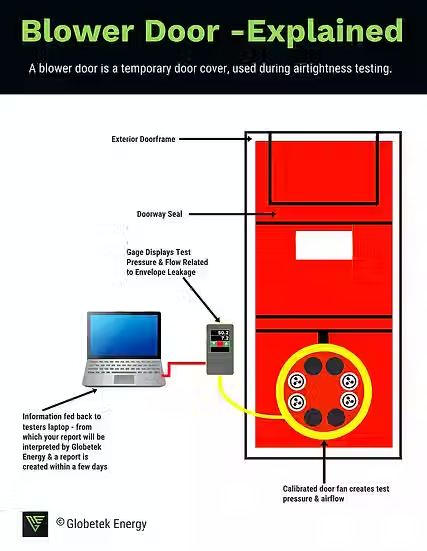
Air Tightness Testing
At Globetek Consulting, we provide professional airtightness testing services specifically tailored for domestic properties. Whether building a new home or upgrading an existing one, our expert team helps ensure your property meets current building regulations and achieves optimal energy efficiency. Using advanced technology, we accurately detect air leaks that can lead to heat loss, higher energy bills, and reduced comfort.
Our detailed reports confirm compliance with regulations and offer practical guidance on improving your home’s performance. With Globetek Consulting, you can confidently build or renovate, knowing your home is sealed, efficient, and future-ready.
What Is Air Tightness Testing?
Air leakage means that air is moving in and out of a building without control. When warm air rises, it tries to escape the building quickly, pulling in cold air to take its place.
If a building is tightly sealed using airtightness testing, the air inside changes less often, and it requires less energy to keep it warm.
New building regulations require all new homes to meet a specific airtightness level.
Here's how our air tightness test works:
1. Preparation:
The process begins with thorough preparation. This involves closing all windows and doors and temporarily sealing any openings, such as vents. The goal is to isolate the building from external air influences.
2. Installation of Testing Equipment:
Specialised equipment, including a blower door, is installed in an external doorway. The blower door consists of a powerful fan that depressurises or presses the building, creating a pressure difference between the interior and exterior.
3. Pressure Adjustment:
The blower door is activated to either pressurise or depressurise the building. This change in pressure helps simulate the effects of wind and other environmental conditions on the building envelope.
4. Detection of Leaks:
As the pressure is adjusted, technicians use specialised tools such as smoke pencils or infrared cameras to detect air leaks. These leaks can occur around the building envelope's windows, doors, electrical outlets, and other penetrations.
5. Quantification of Air Leakage:
The amount of air leakage is quantified by measuring the airflow created by the blower door at the specified pressure (50 pascals). This measurement is typically expressed in air changes per hour (ACH) or cubic feet per minute (CFM) and clearly indicates the building's overall air tightness performance.
6. Identification of Problem Areas:
Technicians can identify areas where air leakage occurs. This information is crucial for any subsequent remediation efforts and can help improve the building's overall energy efficiency and comfort.
7. Reporting:
A comprehensive report is generated based on the test results.
Why do you need airtightness testing?
There are many reasons why you might need air tightness testing:
-
Improve Energy Efficiency
-
Ensure Building Regulation Compliance
-
Enhance Indoor Comfort
-
Prevents Moisture and Mould Issues
-
Boost Property Value





